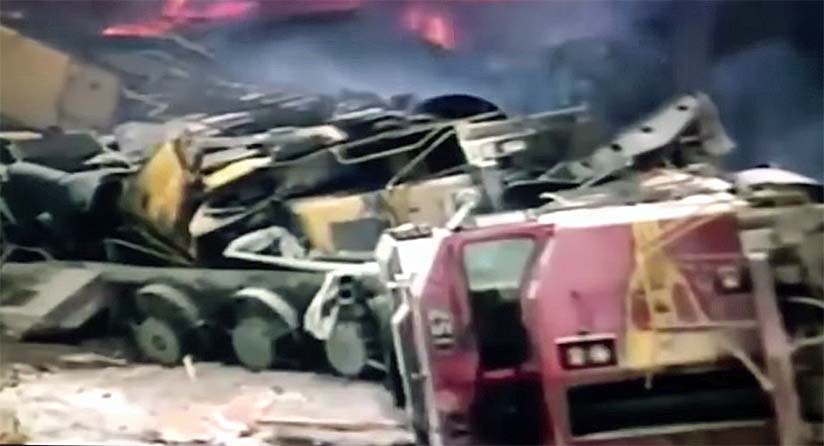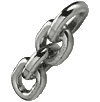
A freight train carrying dangerous chemicals plunged from the rails on a steep downgrade in the Cajon Pass and exploded in flames before dawn Thursday, hurling a noxious cloud into the sky that forced the closure of a major transcontinental highway.
Two bodies found near the Burlington Northern Santa Fe (BNSF) tracks were believed those of two brakemen who apparently leaped from the 49 car train as it hurtled down the canyon.
The train's engineer, who suffered a broken back in the crash, was pulled from the wreckage by three men who braved the spreading fire and fumes to save him.
"It was a monstrous fire, flames going 600 to 800 feet in the air, burning bad and burning high," said one of the rescuers, 67-year-old Gerald Davis.
"We saw the engineer trying to get out of the cab. Several diesel fuel tanks were exploding in the locomotive behind him."
"When you see someone in that position, only one thing crosses your mind," Davis' son-in-law, Rick Eastman, recalled later.
"You've got to get him out of there."
The noxious cloud, generated by flaming chemicals that continued to burn hours after the 04:00 crash, prompted the evacuation of the entire 10 mile long canyon and shut down all traffic on Interstate 15, the principal highway between Southern California and Las Vegas.
I-15 is not expected to reopen until the afternoon.
The Cajon Pass is one of the few routes through the mountains that ring the Southland, and long delays resulted as traffic detoured 100 miles or more around the crash site, 15 miles north of San Bernardino.
The accident occurred in the same area where a runaway Santa Fe freight train slammed into a parked coal train in 1994, injuring two crewmen.
Five years earlier, a Southern Pacific freight train careened out of control down a parallel track in the Cajon Pass before plunging over an embankment into seven homes in San Bernardino, killing two boys in one home.
The cause of Thursday's crash was not immediately determined.
The National Transportation Safety Board (NTSB) said it could be late today before the fire is fully out and investigators are able to study the site.
However, sources close to the investigation said the brakemen's apparent decision to leap would seem to indicate that the train was accelerating out of control, either because of brake failure or crew error.
The sort of sabotage that caused the fatal derailment of an Amtrak train in Arizona last fall was not suspected.
Officials said the train that crashed Thursday had been heading to Los Angeles from Barstow before dawn with a mixed load of freight that included tank cars containing trimethyl phosphite, butyl acrylate, denatured alcohol, and petroleum distillates, all of which are highly flammable.
Trimethyl phosphite is a catalyst used in manufacturing, and butyl acrylate is used in the manufacture of plastics.
Fumes from both can burn skin and eyes, and both cause irritation to nasal and esophageal passages if inhaled.
Although the exact scenario is not yet clear, sources close to the investigation said the train apparently was accelerating downgrade, out of control, when it toppled from the tracks on an S curve a few hundred yards north of the intersection of California 138 and I-15.
The four locomotives and 45 of the 49 cars tumbled together in a shattered heap that instantly began to burn.
Loretta Davis, 58, an early riser who lives nearby, said she was looking out her kitchen window "when I saw this amazing red fireball."
"When I looked across to where there's a wall of rocks, it was bright red, like molten lava. The flames were going up and up and up," she said.
She told her husband, Gerald Davis, what she had seen.
Gerald Davis awakened his son, Patrick, telephoned Eastman, who lives nearby, and the three of them raced down the hill to where the lead locomotive lay tipped on its right side, its nose buried in the bottom of a sandy wash.
Patrick Davis, 33, said he could see the engineer, who has not been identified, "poking his head out of the cab."
"He was completely delirious. He said his back was hurting. He was asking me where he was. I asked him if there were any others there with him. He couldn't tell me anything," Davis said.
Davis said that as burning oil from the ruptured fuel tanks of the second locomotive began advancing down the wash toward them, he and Eastman, 49, realized that they needed to act fast.
Reaching up through the cab window, they pulled the engineer from the locomotive and supported him as he limped to relative safety behind a large boulder, about 40 yards from the wreckage.
There, they covered him with the bathrobe that Patrick Davis had been wearing to ward off the chill of the night.
"When I turned around to look back at the locomotive, there was a big white flash," Davis said.
By then, investigators said, the tank cars were beginning to explode, spewing their volatile contents in an expanding cloud that spread quickly across the canyon.
I-15 was still open at that time, and motorists found themselves enveloped by the cloud before they realized what was happening.
The drivers of four big-rig trucks that rolled north through the plume stopped later in Barstow, where fire department medical personnel treated them for nausea.
Several police officers and transportation officials were examined at local hospitals after complaining of chest pains, shortness of breath, and skin rashes.
Patrick Davis, who was having difficulty breathing, was admitted to St. Bernardine's Hospital in San Bernardino, where he later was listed in serious condition, suffering from chemical inhalation.
The locomotive engineer was listed in fair but stable condition at Community Hospital in San Bernardino.
The brakemen, whose bodies were recovered late Thursday, were not immediately identified.
There apparently were no other crewmen on the train.
David Gunther, a safety official for the Burlington Northern Santa Fe, said the train crew was fully qualified to make the run.
"This is a crew that works on this mountain all the time. They are veterans. Nobody runs on this mountain who's not qualified," Gunther said.
Jim Poe, another safety official for the railroad, said the train should have been traveling at no more than 15 mph as it descended through the pass, created by the San Andreas Fault, that separates the San Gabriel and San Bernardino mountains.
Alan Pollock, a spokesman for the NTSB, said recording devices on the locomotives should be recoverable from the wreckage, "and if they were turned on" they will show the train's speed, throttle settings, and brake settings in the moments before the crash.
Many tourists and High Desert commuters were left frustrated and angry by the decision to keep I-15 closed for what could be as long as 36 hours, but the closure was handled in stride by experienced truck drivers.
The truckers worked their CB radios and took different routes, adding 100 miles or more to their trips, to get their freight through.
"They're dropping their wings and they're flying," quipped one truck dispatcher.
"It's causing some delay but it's not something that can't be dealt with. It's an inconvenience, but not a major problem," said Bruce Gebhardt, vice president of marketing for Viking Freight Systems.
Las Vegas officials said they expect little disruption in the stream of gamblers to the city.
About one-third of the city's visitors come by car from Southern California.
"Because there are alternate routes that people can take, and because this happened on a Thursday and not a Friday, the effect on drive-in traffic from Los Angeles should be negligible. If this had happened sometime on Friday, it would have had quite an impact," said Rob Powers, spokesman for the Las Vegas Convention and Visitors Authority.
The Stardust Hotel has had few cancellations, and the hotel was 97 percent booked for Thursday night. In fact, we have some friends driving in from Los Angeles who were supposed to take Interstate 15. They just called AAA and got an alternate route. They're coming, said Jim Seagrave, vice president of marketing and advertising.
Tom Gorman and Eric Malnic.
provisions in Section 29 of the Canadian
Copyright Modernization Act.










